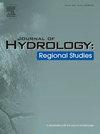Impact of vegetation restoration on preferential flow and soil infiltration capacity in the hilly region of the Loess Plateau
IF 4.7
2区 地球科学
Q1 WATER RESOURCES
引用次数: 0
Abstract
Study region
The Zhifanggou Watershed, a typical watershed in the hilly region of Loess Plateau in China.
Study focus
Assessing effects of various vegetation types on soil water infiltration facilitates understanding of soil hydrological processes and provides valuable references for reforestation in arid areas. Double-ring infiltrometers and dye tracing were employed across plots with various vegetation types and restoration durations to comprehensively investigate the impact of vegetation restoration on soil infiltration capacity, preferential flow, and their influencing factors.
New hydrological insight for the region
The results showed that the highest stable infiltration rate occurred in 30-year-old replanted monoculture forestland (0.57 cm min⁻¹), followed by 30-year-old replanted shrubland (0.42 cm min⁻¹). Monocultured forestland had slightly higher soil infiltration rates than mixed forestland, with macropore flow was dominant. Mixed forestlands exhibited the highest degree of preferential flow and the most preferential flow paths. Soil infiltration capacity and preferential flow paths increased with restoration years, and preferential flow was promoted in deeper soil layers. Soil macroporosity, clay content, and root length density predominantly influenced soil infiltration capacity and dye-stained characteristics parameters. Root characteristics were critical for the degree of preferential flow, with rock fragment and cracks also being not negligible factors. These findings could deepen our understanding of vegetation restoration in improving soil hydrological functions, and provide a reference for the management of vegetation restoration.
黄土丘陵区植被恢复对优先流和土壤入渗能力的影响
研究区域:黄土高原丘陵区典型小流域—方沟小流域。研究重点评价不同植被类型对土壤水分入渗的影响有助于认识土壤水文过程,为干旱区的再造林提供有价值的参考。采用双环入渗仪和染料示踪法,在不同植被类型和恢复时间的样地,综合考察了植被恢复对土壤入渗能力、优先流量及其影响因素的影响。结果表明,30年的单一栽培林地的稳定入渗率最高(0.57 cm min⁻¹),其次是30年的灌丛(0.42 cm min⁻¹)。单作林地土壤入渗速率略高于混作林地,以大孔流为主。混交林表现出最高的优先流动程度和最优先的流动路径。土壤入渗能力和优先流道随着修复年限的增加而增加,且优先流道在较深土层中得到促进。土壤宏观孔隙度、粘粒含量和根长密度对土壤入渗能力和染色特性参数影响较大。根系特征是决定优先流动程度的关键因素,岩石破碎和裂缝也是不可忽视的因素。这些发现可以加深我们对植被恢复改善土壤水文功能的认识,并为植被恢复的管理提供参考。
本文章由计算机程序翻译,如有差异,请以英文原文为准。
求助全文
约1分钟内获得全文
求助全文
来源期刊

Journal of Hydrology-Regional Studies
Earth and Planetary Sciences-Earth and Planetary Sciences (miscellaneous)
CiteScore
6.70
自引率
8.50%
发文量
284
审稿时长
60 days
期刊介绍:
Journal of Hydrology: Regional Studies publishes original research papers enhancing the science of hydrology and aiming at region-specific problems, past and future conditions, analysis, review and solutions. The journal particularly welcomes research papers that deliver new insights into region-specific hydrological processes and responses to changing conditions, as well as contributions that incorporate interdisciplinarity and translational science.
 求助内容:
求助内容: 应助结果提醒方式:
应助结果提醒方式:


